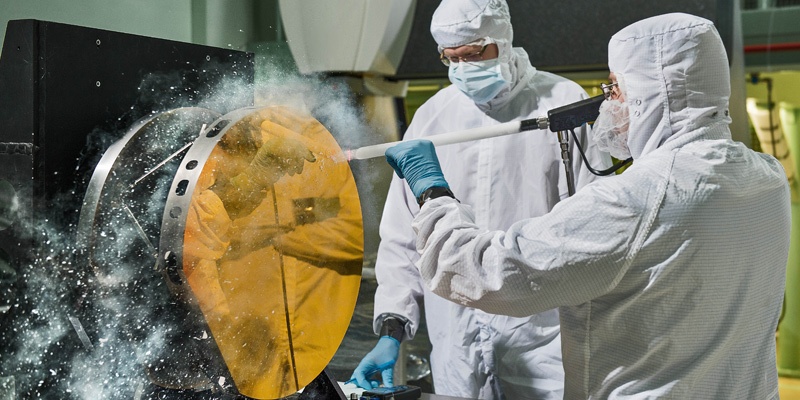About the Cleaning and Maintenance of 100,000-Class Clean Rooms
100,000-class clean rooms are essential in industries such as pharmaceuticals, biotechnology, and Electronics, where contamination control is critical. Maintaining these environments involves rigorous cleaning protocols and regular maintenance to ensure compliance with cleanliness standards.

1. Understanding Clean Room Classifications
Clean rooms are classified based on the maximum allowable particle count per cubic meter. In a 100,000-class clean room, the limit is 3,520,000 particles per cubic meter for particles ≥0.5 micrometers. This classification ensures that the environment is suitable for sensitive processes and products.
Classification Standard: ISO 14644-1.
Particle Count Limit: 3,520,000 particles/m³ (≥0.5 micrometers).
Application: Pharmaceuticals, biotechnology, electronics.
2. Cleaning Protocols
Cleaning protocols in a 100,000-class clean room must be meticulously followed. The cleaning process typically involves daily, weekly, and monthly routines. Daily cleaning includes mopping and dusting, while weekly tasks might involve deep cleaning and equipment sanitization. Monthly protocols often include detailed inspections and maintenance of the HVAC systems.

3. Cleaning Agents and Techniques
Choosing appropriate cleaning agents is crucial, as they must be compatible with clean room standards. Commonly used agents include disinfectants and detergents that are non-volatile and free from particulates. Techniques such as wet cleaning and the use of microfiber materials are recommended to minimize particle generation.
4. Maintenance of Clean Room Equipment
Regular maintenance of clean room equipment is vital for optimal performance. This includes routine checks and calibrations of air filtration systems, temperature, and humidity controls. According to ISO 14644-3, monitoring of environmental parameters should be conducted at least quarterly.
5. Personnel Training and Compliance
Personnel working in clean rooms must undergo regular training to understand cleaning protocols and contamination control measures. Training should be documented and updated at least annually to ensure compliance with industry standards such as ISO 13485 for medical devices.
Training Frequency: At least annually.
Documentation: Maintain records of training sessions.
Relevant Standard: ISO 13485.

Relevant Standards and Guidelines
iso 14644-1: Cleanrooms and controlled environments.
ISO 13485: Quality management systems for medical devices.
What are the Air Changes for Class 100,000 Clean Room?

Air Change Rate
A Class 100,000 cleanroom typically requires 15 to 30 air changes per hour. This high rate ensures that airborne particles are effectively removed, maintaining the required cleanliness levels.
airflow design
The airflow design is crucial for achieving the necessary air changes. Properly designed ventilation systems distribute filtered air uniformly, reducing dead zones and ensuring consistent cleanroom conditions.

Filtration Systems
High-efficiency particulate air (HEPA) filters are standard in Class 100,000 cleanrooms. These filters capture at least 99.97% of particles measuring 0.3 micrometers or larger, maintaining air quality.
Monitoring Requirements
Regular monitoring of air changes is essential for compliance. Continuous air quality assessments help identify any deviations from standards, ensuring operational integrity and cleanliness.
What are the Classifications of Cleaners?

1. Disinfectants:Disinfectants are designed to kill bacteria and viruses on surfaces. These products often contain chemical agents that effectively reduce microbial contamination, making them suitable for healthcare settings.
2. Sterilants:Sterilants are used to eliminate all forms of microbial life, including spores. These products are essential in environments where absolute sterility is required, such as surgical and pharmaceutical applications.
3. Specialty Cleaners:Specialty cleaners are formulated for specific applications, such as electronics or critical environments. They are designed to clean without leaving residues that could contaminate sensitive equipment or products.
Do Cleaning Products Need FDA Approval?

Antimicrobial Products
Cleaning products that claim to kill germs or bacteria may be classified as antimicrobial agents. Such products require registration with the EPA and must meet established efficacy standards.
Medical Device Cleaning
Cleaning products used for medical devices are subject to more stringent regulations. These products must demonstrate effectiveness in decontaminating devices, requiring FDA clearance or approval.
Labeling Requirements
All cleaning products must have accurate labels that provide information on ingredients and usage instructions. Misleading claims can lead to regulatory action, ensuring consumer safety and informed choices.
What are the ISO 8 Standards for Clean Rooms?

1. Air Quality Control
Maintaining air quality in ISO 8 Cleanrooms requires effective filtration systems, typically using HEPA filters. These systems help to reduce airborne contaminants and maintain the required cleanliness levels.
2. Operational Procedures
Strict operational procedures must be implemented in ISO 8 cleanrooms. These include gowning protocols, routine cleaning schedules, and staff training to minimize contamination risks.
What are the GMP Guidelines for Clean Rooms?

GMP guidelines dictate that cleanrooms must be designed to minimize contamination risks. This includes proper airflow, surfaces that are easy to clean, and controlled access to reduce personnel-related contamination.
Documentation and Records
Maintaining thorough documentation is a key GMP requirement. Records of cleaning procedures, environmental monitoring results, and maintenance activities must be kept to ensure accountability and compliance.
Validation and Verification
Validation of cleaning processes and equipment is necessary under GMP. Regular inspections and testing ensure that cleanrooms operate within specified parameters, safeguarding product quality.
 +86 18186671616
+86 18186671616 Jason@cleanroomequips.com
Jason@cleanroomequips.com
 MENU
MENU



